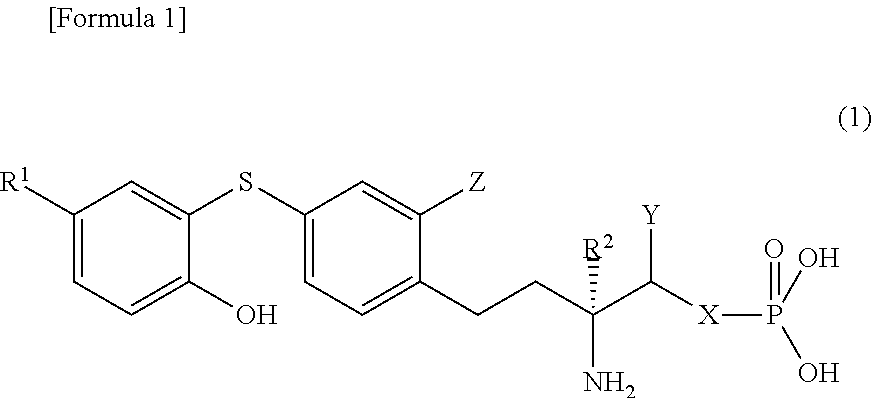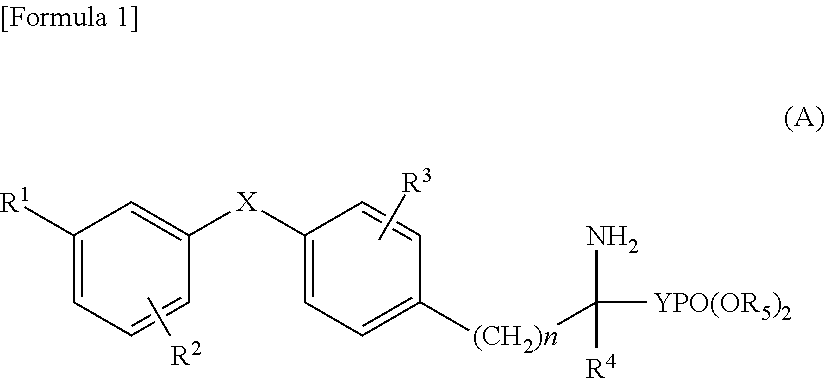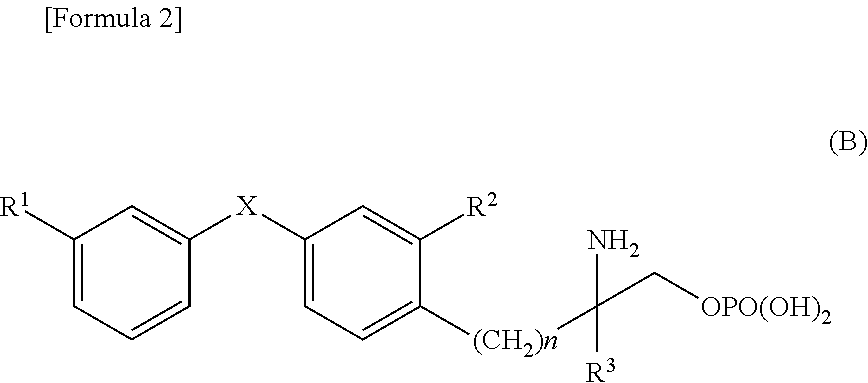Diphenyl sulfide derivatives and medicines containing same as active ingredient
a technology of sulfide derivatives and active ingredients, applied in the direction of phosphorous compound active ingredients, immunological disorders, extracellular fluid disorders, etc., can solve the problems of increased vascular wall permeability, pulmonary edema, etc., and achieve excellent s1p3 antagonistic action
- Summary
- Abstract
- Description
- Claims
- Application Information
AI Technical Summary
Benefits of technology
Problems solved by technology
Method used
Image
Examples
reference example 2
(2R,5R)-2-allyl-2-(4-bromo-2-chlorophenyl)ethyl-3,6-dimethoxy-5-isopropyl-2,5-dihydropyrazine
[0230]
[0231]The target product (6.04 g) was obtained as a colorless oil by reacting (5R)-2-allyl-3,6-dimethoxy-5-isopropyl-2,5-dihydropyrazine (3.64 g) in the same manner as in Reference Example 1.
[0232]1H NMR (CDCl3, 400 MHz): δ 0.69 (3H, d, J=6.7 Hz), 1.10 (3H, d, J=6.7 Hz), 1.79 (1H, ddd, J=12.8, 11.6, 4.9 Hz), 2.02 (1H, ddd, J=12.8, 11.6, 4.9 Hz), 2.27-2.48 (4H, m), 2.54 (1H, dd, J=13.4, 7.3 Hz), 3.69 (3H, s), 3.70 (3H, s), 3.95 (1H, d, J=3.1 Hz), 4.97 (1H, dd, 10.4, 2.4 Hz), 5.01 (1H, d, J=17.7 Hz), 5.61-5.72 (1H, m), 7.01 (1H, d, J=7.9 Hz), 7.27 (1H, dd, J=7.9, 1.8 Hz), 7.47 (1H, d, J=1.8 Hz).
[0233]ESIMS (+): 441 [M+H]+.
reference example 3
Methyl(S)-4-(4-bromo-2-chlorophenyl)-2-t-butoxycarbonylamino-2-methyl butyrate
[0234]
[0235]0.5 mol / L hydrochloric acid (200 mL) was added to a solution of the compound of Reference Example 1 (8.40 g) in 1,4-dioxane (400 mL) to form a first reaction solution. This first reaction solution was stirred at normal temperature for 1 hour, and then left to stand at normal temperature overnight. Then, the first reaction solution was concentrated, neutralized with a saturated sodium hydrogen carbonate aqueous solution, and extracted with ethyl acetate. The extract was washed with water and saturated brine, and then dried over anhydrous sodium sulfate. After the anhydrous sodium sulfate was removed by filtration, the extract was concentrated, and the resultant residue was dissolved in acetonitrile (16 mL). Di-tert-butoxydicarbonate (11.0 g), was added to this solution to form a second reaction solution. This second reaction solution was stirred at normal temperature for 1 hour and then left to ...
reference example 4
Methyl(R)-2-allyl-4-(4-bromo-2-chlorophenyl)-2-t-butoxycarbonylamino butyrate
[0238]
[0239]A solution of 50% trifluoroacetic acid-water (108 mL) was added to the compound of Reference Example 2 (5.44 g) to form a first reaction solution. This first reaction solution was stirred at normal temperature for 1 hour, and then left to stand at normal temperature overnight. Then, the first reaction solution was neutralized with a saturated sodium hydrogen carbonate aqueous solution, and extracted with ethyl acetate. The extract was washed with water and saturated brine, and then dried over anhydrous sodium sulfate. After the anhydrous sodium sulfate was removed by filtration, the extract was concentrated, and the resultant residue was dissolved in acetonitrile (86 mL). Di-tert-butoxydicarbonate (11.0 g) was added to this solution to form a second reaction solution. This second reaction solution was stirred at normal temperature for 1 hour and then left to stand at normal temperature overnight...
PUM
| Property | Measurement | Unit |
|---|---|---|
| cell morphology | aaaaa | aaaaa |
| vascular wall permeability | aaaaa | aaaaa |
| optically active | aaaaa | aaaaa |
Abstract
Description
Claims
Application Information
 Login to View More
Login to View More - R&D
- Intellectual Property
- Life Sciences
- Materials
- Tech Scout
- Unparalleled Data Quality
- Higher Quality Content
- 60% Fewer Hallucinations
Browse by: Latest US Patents, China's latest patents, Technical Efficacy Thesaurus, Application Domain, Technology Topic, Popular Technical Reports.
© 2025 PatSnap. All rights reserved.Legal|Privacy policy|Modern Slavery Act Transparency Statement|Sitemap|About US| Contact US: help@patsnap.com



